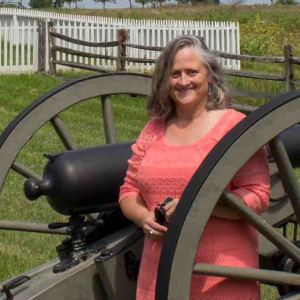Cultural Resources Program Manager (Historian)
Gettysburg National Military Park and Eisenhower National Historic Site
 Responsibilities:
Responsibilities: Peterson preserves cultural resources at both sites, which means “rehabilitating the landscape to look like it did historically. I don’t just look at a building. I understand how that building interacted with a nearby farmstead and crop.” Unlike an academic historian, who records and interprets the past by writing and teaching about it, Peterson’s work is hands-on, primarily related to the ongoing restoration of the Gettysburg site so visitors get a better sense of what it was like during the Civil War. For example, using letters from soldiers and maps drawn in preparation for the Battle at Gettysburg, she determined where stone walls and trees stood, and then found the actual ones hidden in 150 years of overgrowth. “Osage-orange trees [also known as hedge apple] were commonly used as a hedge during the 19th century because cows wouldn’t crawl through it. A soldier wrote about Osage-orange trees in the context of the artillery needing to see what it was firing at. I determined where that was. We cleared away the woods and found Osage-orange trees. It gave me goose bumps. Then I had to figure out how it fit with the landscape from that time period.”
Years in current position: 21
Years with the Park Service: 35
Career path: Peterson grew up just 14 miles from Gettysburg on a small farm. She started working at Gettysburg National Military Park three days after her high school graduation as a summer job. After earning a degree in recreation from Penn State with an emphasis on history, she landed an internship at Everglades National Park then returned to her first passion at Gettysburg.
What makes my park special: “The story of not only the battle but of the nation is here. It’s a place for reflection, to think about things that happened, the sacrifices made and how it affected an entire country. We’ve added avenues to get around and monuments, but it’s still a powerful place where you remember the past and its implications for the future.”
Typical day: “I’m the institutional knowledge of the park. No day goes as planned. I just try to stay ahead of the tsunami. The bulk of what I do is behind the scenes, such as determining whether a roof needs to be cedar shingles in order to fit with the national historic site regulations. The changes you see when you come here are a result of what I do.”
Biggest challenge: “The number of people who are professionals in cultural resources in the National Park Service has shrunk dramatically. When my colleague retired in 2012, the position was not filled but the tasks still have to happen. It’s all important, and I want it all to be done right.”
Best part of job: “The variety. I’m a multi-tasker, and I want to make a difference. I learn something new every day.”
Advice for visitors: “Be mindful of how your experience here impacts others. The monuments are fragile, even though they are made of stone and bronze.”
Favorite national park: “Theodore Roosevelt National Park. You can see why Native Americans attach legends to the land. The whole conservation ethic is personified in that landscape. And I got to see a bison!”
Learn more about our national parks! View historic photos, listen to audio on how the film, "Our National Parks: America's Best Idea," was created, and learn about activities and events the park system offers.